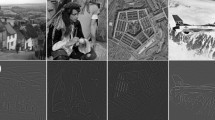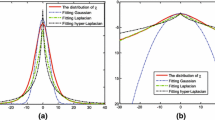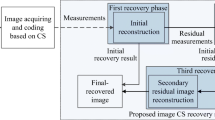Abstract
Inpainting images with occlusion or corruption is a challenging task. Most existing algorithms are pixel based, which construct a statistical model from image features. However, in these algorithms, the frequency component is not sufficiently addressed. In this paper, we propose a novel algorithm that utilizes compressed sensing (CS) in frequency domain to reconstruct corrupted images. In order to reconstruct image, we first decompose the image into two functions with different basic characteristics — structure component and textual component. We seek a sparse representation for the functions and use the DCT coefficients of this representation to generate an over-complete dictionary. Experimental results on real world datasets demonstrate the efficacy of our method in image inpainting. We compare our method with three state-of-the-art inpainting algorithms and demonstrate its advantages in terms of both quantitative and qualitative aspects.
Similar content being viewed by others
References
Shih TK, Chang R-C, Lu L-C, Ko W-C,WC-C. Adaptive digital image inpainting. In: Proceedings of the Advanced Information Networking and Applications. 2004, 71–76
Zhu Z, Li Z, Rahardja S, Franti P. Recovering real-world scene: highquality image inpainting using multi-exposed references. Electronics Letters, 2009, 45(25): 1310–1312
Li T, Zhao M. Image inpainting with salient structure completion and texture propagation. Pattern Recognition Letters, 2011, 32(1): 1256–1266
Qin C, Wang S, Zhang X. Simultaneous inpainting for image structure and texture using anisotropic heat transfer model. Multimedia Tools and Applications, 2012, 56(3): 469–483
Qi F, Han J, Wang P, Shi G, Li F. Structure guided fusion for depth map inpainting. Pattern Recognition Letters, 2013, 34(1): 70–76
Rane SD, Sapiro G, Bertalmio M. Structure and texture filling-in of missing image blocks in wireless transmission and compression applications. IEEE Transactions on Image Processing, 2003, 12(3): 296–303
Criminisi A, Pérez P, Toyama K. Region filling and object removal by exemplar-based image inpainting. IEEE Transactions on Image Processing, 2004, 13(9): 1200–1212
Mairal J, Elad M, Sapiro G. Sparse representation for color image restoration. IEEE Transactions on Image Processing, 2008, 17(1): 53–69
Xu Z, Sun J. Image inpainting by patch propagation using patch sparsity. IEEE Transactions on Image Processing, 2010, 19(5): 1153–1165
Donoho D L. Compressed sensing. IEEE Transactions on Information Theory, 2006, 52(4): 1289–1306
Candès E, Romberg J, Tao T. Robust uncertainty principles: exact signal reconstruction from highly incomplete frequency information. IEEE Transactions on Information Theory, 2006, 52(2): 489–509
Liang X, Ren X, Zhang Z, Ma Y. Repairing sparse low-rank texture. In: Proceedings of the 12th European Conference on Computov Vision, 2012, 482–495
Guleryuz G. Nonlinear approximation based image recovery using adaptive sparse reconstructions and iterated denoising -part II: adaptive algorithms. IEEE Transactions on Image Processing, 2006, 15(3): 555–571
Baraniuk R. More is less: signal processing and the data deluge. Science, 2011, 331(6018): 717–719
Baraniuk R. Compressive sensing. IEEE Signal Processing Magazine, 2007, 24(4): 118–121
Bertalmio M, Vese L, Sapiro G, Osher S. Simultaneous structure and texture image inpainting. IEEE Transactions on Image Processing, 2003, 12(8): 882–889
Rudin L, Osher S, Fatemi E. Nonlinear total variation based noise removal algorithms. Physica D: Nonlinear Phenomena, 1992, 60(1): 259–268
Meyer Y. Oscillating Patterns in Image Processing and Nonlinear Evolution Equations: the Fifteenth Dean Jacqueline B. Lewis Memorial Lectures. USA: American Mathematical Society, 2001
Huynoh-Thu Q, Ghanbari M. Scope of validity of psnr in image/video quality assessment. Electronics Letters, 2008, 44(13), 800–801
Li X. Image recovery via hybrid sparse representations: A deterministic annealing approach. IEEE Journal of Selected Topics in Signal Processing, 2011, 5(5): 953–962
Dong W, Shi G, Li X. Nonlocal image restoration with bilateral variance estimation: a low-rank approach. IEEE Transactions on Image Processing, 2013, 22(2): 700–711
Author information
Authors and Affiliations
Corresponding author
Additional information
Qiang Li is pursuting his PhD in School of Computer Science and Technology, Tianjin University, China. His research interests include machine learning based image and video processing, and data mining.
Yahong Han received the PhD degree from Zhejiang University, Hangzhou, China. He is currently an associate professor in School of Computer Science and Technology, Tianjin University, Tianjin, China. His current research interests include multimedia analysis, retrieval, and machine learning.
Jianwu Dang graduated from Tsinghua University, China in 1982, and got his MS at the same university in 1984. He worked for Tianjin University as a lecturer from 1984 to 1988. He was awarded the PhD from Shizuoka University, Japan in 1992. He worked for ATR Human Information Processing Labs., Japan, as a senior researcher from 1992 to 2001. He joined the University ofWaterloo, Canada, as a visiting scholar for one year from 1998. Since 2001, he has moved to Japan Advanced Institute of Science and Technology (JAIST). He joined the Institute of Communication Parlee (ICP), Center of National Research Scientific, France. He is as “One Thousand Plan” distinguished expert in China since 2010 and National “973 Project” chair scientist. His research interests are in all the fields of signal processing.
Rights and permissions
About this article
Cite this article
Li, Q., Han, Y. & Dang, J. Image decomposing for inpainting using compressed sensing in DCT domain. Front. Comput. Sci. 8, 905–915 (2014). https://doi.org/10.1007/s11704-014-3398-x
Received:
Accepted:
Published:
Issue Date:
DOI: https://doi.org/10.1007/s11704-014-3398-x




